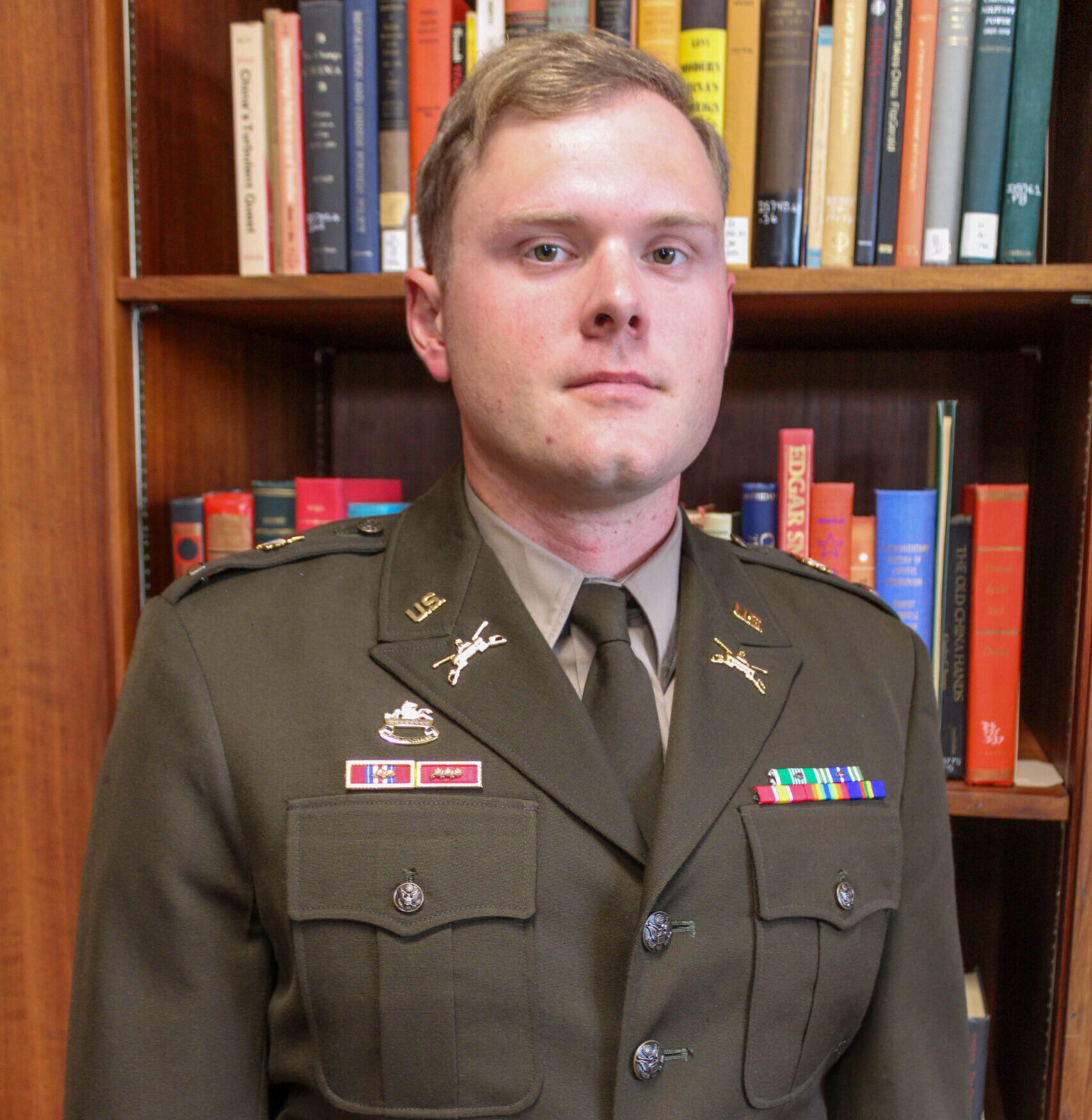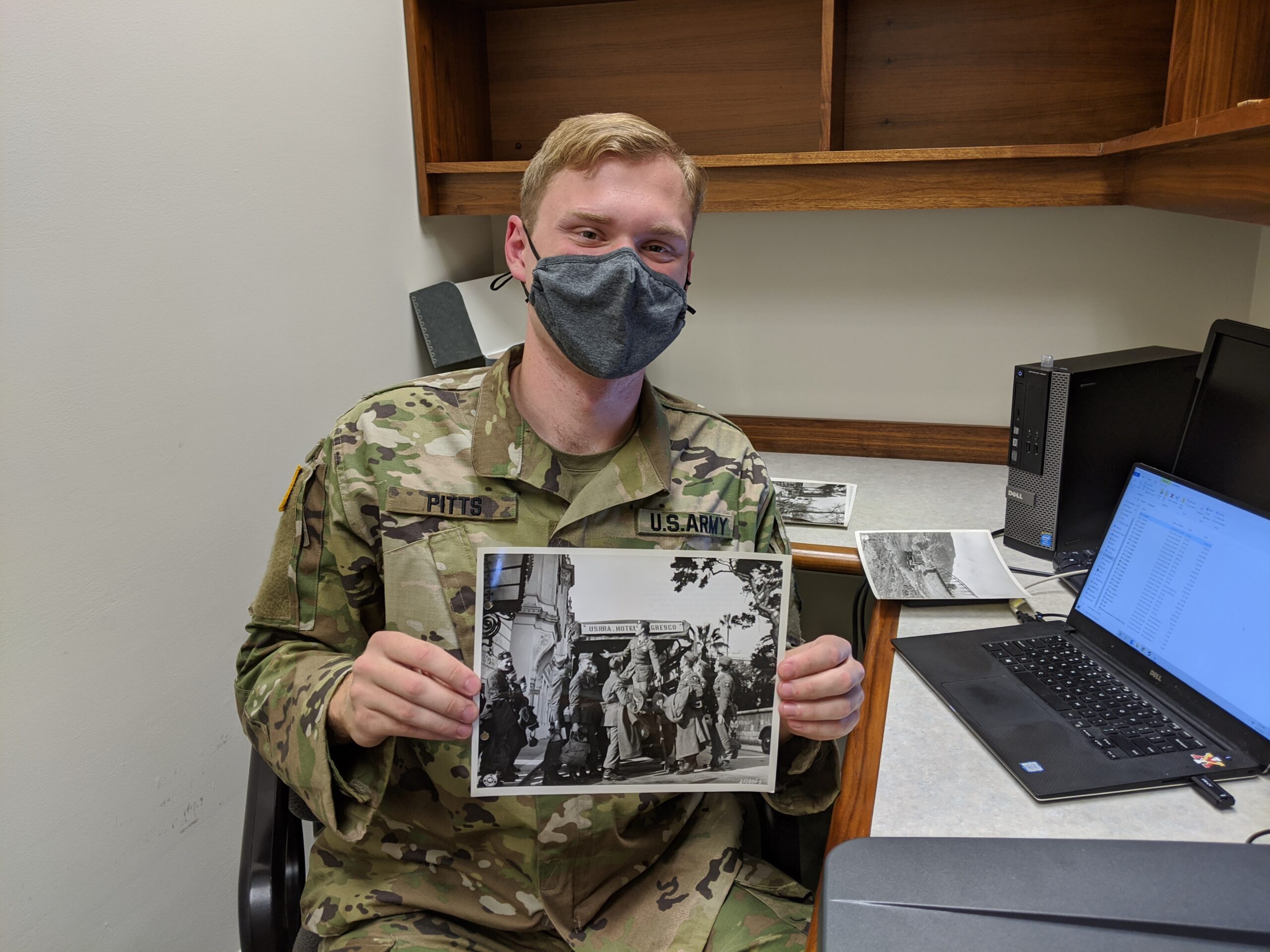Five-Star Spotlight is an ongoing interview series with the researchers, supporters, interns, volunteers, and leaders who make the George C. Marshall Foundation possible.
In this installment, Director of Communications and Multimedia Glen J. Carpenter talks with former Marshall Foundation archival intern, 1st Lt. Darren Pitts, VMI ’21, about his work, Marshall’s example, and the applicable lessons from his leadership.
Glen Carpenter
Could you please tell us a bit about yourself?
1st Lt. Darren Pitts
My name is Darren Pitts. I’m a 2021 graduate of VMI. I’m currently a first lieutenant in the U.S. Army. During my time at VMI, I was an intern at the archives here at the George C. Marshall Foundation.
GC
How did you become interested in the Marshall Foundation?
1st Lt. Pitts
The reason I went to VMI was because of George Marshall. I read a few biographies about him and was really inspired by his character, personality and his leadership, and was interested in coming to VMI because of that. One day, I walked over to the library, met Director of Library and Archives Melissa Davis, and ended up starting a part time internship here as a cadet, going through the archives and helping digitize different parts of the U.S. Army Signal Corps collection.
GC
What did that entail?
1st Lt. Pitts
During World War II, the Army Signal Corps was responsible for documenting the conflict and the day-to-day lives of soldiers through photography and other means. The Foundation has thousands and thousands of photographs in that collection. I went through one by one, digitizing these photos—it was really neat because they’re an insight into the experiences of millions of GIs during the war.
GC
Were there any items you found that stood out in particular?
1st Lt. Pitts
There were a couple. I was interested in the amphibious operations across the Rhine River—it’s something you don’t really hear about or see.
GC
Yes, I remember when you found that photo of Higgins boats being used in those operations.
1st Lt. Pitts
I never realized that Higgins boats had been used across the Rhine. It was a monumental operation that gets dwarfed by all the other amphibious operations in World War II—D-Day, Dragoon—it’s bottom of the list. But in reality, it was a huge undertaking. There was also a series of photos of GIs on R&R in southern France in late 1944. They were neat because they were more relaxed, guys just shaving and messing around in bars, things like that. Definitely not formal, but it was interesting to see that different side of the GI experience.
GC
You mentioned that you had read a few biographies of Marshall.
1st Lt. Pitts
Yes—I was in Europe last year for nine months, so I brought a few. The last one I read was George C. Marshall: Defender of the Republic by David Roll. I also worked through Marshall’s manuscript of his World War I memoirs, which obviously went unpublished, so it wasn’t the most polished thing I’ve ever read. But it was interesting to see his experience.
I enjoy reading biographies of Marshall because they really push me back into place. In my career developing as an Army officer, I spent a lot of time on staff. Obviously not the most fun job in the world, but very important in reality. Marshall was the kind of guy that said “I’m going to do the job that needs to be done.” You can get it done, too.
GC
To that point, what characteristics of Marshall do you most admire?
1st Lt. Pitts
His selfless service—he was totally uninterested in glory or anything like that for himself. I think he was very much interested in (as far as being Chief of Staff) winning the war with the fewest number of casualties as quickly as possible. In his mind, he was a servant-leader responsible for eight million GIs, trying to provide them the best quality of life, under the circumstances they found themselves in, anywhere in the world. The Coca-Cola lecture from 2016 is a good example of how Marshall and the Army were trying to provide little pieces of home, and even the USO. I experienced part of that, too, and was appreciative of that part of the legacy of Marshall’s tenure as chief of staff, living on to this day and still positively affecting service members all over the world.
GC
What lessons from Marshall’s life and career could apply to an active duty officer in 2024?
1st Lt. Pitts
There were a lot of changes in the Army over Marshall’s career. The Army he commissioned into was totally different from the Army he led as chief of staff. Right now, the Army’s going through changes, too, coming out of the global war on terror and looking to restructure itself for large-scale combat operations like we saw in World War II—I think it’s very similar to the Army that Marshall led in 1940, 1941. A lot of times, when I find myself getting frustrated, I take a step back and remind myself that Marshall and the leaders he chose went through similar challenges. This is something we’ve done before. We can definitely do it again.
As a cadet at VMI, the George C. Marshall Foundation is an incredible resource. I can only encourage more cadets to visit. Melissa is an outstanding person in addition to being a great archivist and librarian. There are so many different experiences that you can gain from interning or just volunteering. It’s an outstanding resource for anyone at VMI. Marshall is the greatest graduate in the Institute’s history, so just walk across the parade field and come on over.
Glen began working at the George C. Marshall Foundation in 2018 with a background in American studies and video production. He lives in Roanoke, Virginia.


